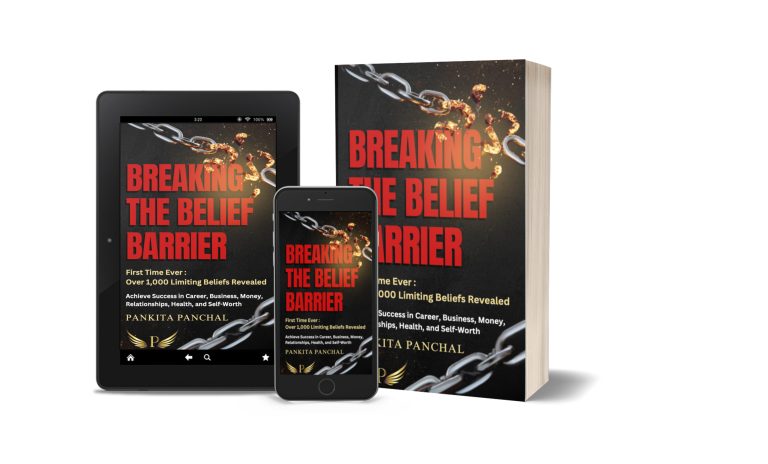Overwhelm and Burnout
Overwhelm and Burnout: How Emotional Healing is the Key to Lasting Productivity Introduction: Do you ever feel like no matter how hard you push yourself, you’re constantly falling behind? Perhaps you’re overwhelmed...

Do you often feel overwhelmed by anxiety, trapped in a cycle of overthinking, exhaustion, and emotional paralysis? If you’ve tried to manage it on your own—through meditation apps, affirmations, or self-help books—but still feel like nothing truly changes, you’re not alone. Many people face the same struggle, feeling like there’s no way out.
The truth is, anxiety is much more than just worry. It’s a collection of deeply suppressed emotions like anger, fear, sadness, and frustration—emotions that, if not released, will keep you stuck in a cycle of mental and physical exhaustion. And while DIY solutions may offer short-term relief, they don’t address the root cause of anxiety.
A 2021 study by the National Institute of Mental Health (NIMH) found that only 30% of people who attempt to manage their anxiety with DIY solutions, like meditation or journaling, report significant long-term improvement. The vast majority—70%—find that their symptoms persist or worsen over time because these methods only treat the surface symptoms of anxiety.
This is where Time Line Therapy™ comes in. Unlike surface-level methods, this powerful, proven technique targets and releases the negative emotions trapped in your subconscious, offering lasting relief. In just two sessions, my clients experience dramatic transformations, regaining control over their lives.
But don’t just take my word for it—let’s explore how anxiety affects you, why so many people get stuck in slow-progress methods, and how Time Line Therapy™ can be your fast-track solution to lasting change.
Anxiety is often misunderstood as just feeling nervous or overwhelmed, but it’s much more complex. It’s tied to unresolved emotions that have been buried in your subconscious for years, maybe even decades. Anger, guilt, fear, and sadness are often at the core of anxiety, and these emotions, when suppressed, manifest as overthinking, lack of focus, avoidance of decisions, and even physical exhaustion.
Your nervous system becomes overwhelmed by these emotions, leading to a constant state of high alert—where everything feels like a potential threat. It’s no wonder you feel stuck.
In fact, a study by the American Psychological Association (APA) found that 80% of people with chronic anxiety have unresolved emotional triggers, such as past trauma, fear of failure, or long-held guilt. These suppressed emotions lead to a continuous cycle of anxiety symptoms, which can make even everyday tasks feel overwhelming.
While anxiety may show up differently for everyone, some of the most common symptoms include:
Overthinking: The Mental Trap That Keeps You Stuck
Overthinking is one of the most common symptoms of anxiety, especially in conditions like Generalized Anxiety Disorder (GAD). When someone experiences anxiety, their brain often gets stuck in a cycle of worrying and overanalyzing situations—this is what we commonly refer to as overthinking. It’s the constant replaying of scenarios, imagining worst-case outcomes, and second-guessing every decision.
Overthinking can intensify anxiety by creating a mental loop where the person feels overwhelmed by hypothetical scenarios, fears, and potential negative outcomes. This endless cycle keeps your mind trapped in stress and worry, making it incredibly difficult to relax or feel at peace.
In fact, overthinking is one of the hallmark behaviors of anxiety because it keeps the mind in a heightened state of stress and uncertainty. This prevents you from moving forward with decisions or enjoying the present moment, further feeding into the anxiety cycle. The more you overthink, the more anxious you feel, and the more anxious you feel, the more you overthink—it’s a vicious cycle.
Over time, overthinking drains your mental energy, leaving you emotionally exhausted and making it even harder to face daily tasks. You might feel paralyzed by indecision, constantly ruminating over what could go wrong, which ultimately makes it impossible to act confidently. The longer you stay stuck in this mental loop, the worse your anxiety becomes, reinforcing your feelings of powerlessness.
According to the Anxiety and Depression Association of America (ADAA), 73% of people with anxiety report overthinking as one of their most debilitating symptoms, preventing them from making decisions or progressing in their personal and professional lives.
Difficulty Focusing: When Your Mind Won’t Cooperate
Anxiety scatters your thoughts, making it nearly impossible to concentrate. You sit down to work or have a conversation, but your mind is always elsewhere, jumping between worries and fears. This lack of focus means you’re never truly present, which impacts your productivity and relationships.
Lack of Energy: Emotional Exhaustion Turns Physical
Anxiety doesn’t just drain you mentally—it takes a toll on your physical energy, too. You might wake up feeling tired, even after a full night’s sleep. The constant stress wears down your body, making simple tasks feel overwhelming. This emotional exhaustion, left unchecked, can lead to full-blown burnout.
The World Health Organization (WHO) noted that individuals with chronic anxiety often experience fatigue or physical exhaustion, with 60% reporting persistent tiredness even when they haven’t been physically active.
Avoiding Decisions: Anxiety Makes You Afraid of Choices
When anxiety takes over, even small decisions feel like life-or-death situations. You might avoid tasks or decisions altogether because you’re terrified of making the wrong choice. This avoidance leads to a buildup of responsibilities, making anxiety worse, and creating a cycle of procrastination and fear.
Physical Symptoms: Anxiety’s Grip on Your Body
Anxiety doesn’t stop at the mind—it affects the body, too. Tension headaches, tight muscles, digestive issues, and rapid heartbeats are common physical signs of anxiety. Your body is in a constant fight-or-flight state, which takes a toll on your health and well-being.
Many people turn to DIY methods—like meditation apps, affirmations, or journaling—to manage their anxiety. While these methods can offer temporary relief, they fail to address the emotional root of the issue. You can journal all you want, but if you don’t release the anger, sadness, fear, or guilt driving your anxiety, the symptoms will persist.
DIY solutions only treat the surface. They’re like putting a band-aid on a wound that needs stitches. The real issue remains untreated, leading to what’s known as the sunk cost fallacy—you keep trying the same methods over and over, hoping for different results, simply because you’ve invested time, money, or effort into them.
But without addressing the emotional root of your anxiety, it keeps coming back. This is where many people get stuck, thinking, “If I just meditate a little longer, maybe it will go away.” But in reality, long-lasting relief requires a deeper approach.
I’ve spoken to countless people who are working with therapists or using techniques that haven’t given them real results—even after a year or more. I understand why you might be hesitant to try something new. After all, change can be scary, and it’s easy to hold on to what’s familiar, even when it’s not working.
But let me ask you this:
If the method you’ve been using hasn’t given you fast, noticeable progress, are you wasting your time and money? How much longer will you keep investing in something that isn’t getting you where you need to be?
A 2022 study by the American Counseling Association found that individuals in long-term therapy who did not address the core emotional triggers of their anxiety saw little to no improvement, with 48% reporting that their anxiety had actually worsened.
It’s a wake-up call—you have the opportunity to make a change. You can either continue with a method that leaves you feeling stuck, or you can try something different that has a proven track record of rapid, lasting results.
If you’ve tried everything else and nothing has worked, it’s because you’re only addressing anxiety’s surface symptoms—not the underlying emotions. That’s why I offer Time Line Therapy™, a powerful method that works by releasing the suppressed emotions fueling your anxiety.
Here’s why Time Line Therapy™ is so effective:
Release Suppressed Emotions: During the sessions, we uncover and release negative emotions—like anger, sadness, and fear—that have been trapped in your subconscious. Once these emotions are released, your mind and body experience immediate relief.
Rewire Your Responses: Time Line Therapy™ helps change how your brain responds to anxiety triggers. Instead of falling into old patterns of overthinking or avoidance, you’ll feel calm, confident, and in control.
Fast, Lasting Results: Unlike traditional therapy that can take months or years, most clients experience significant improvements after just two to four sessions. We’re not wasting time treating symptoms—we’re solving the root cause.
One of my recent clients, T.P., felt overwhelmed with both her personal and professional life. She had reached a breaking point, feeling like she was destined to fail. After just two Time Line Therapy™ sessions, everything changed for her.
Here’s what T.P. had to say:
“I started feeling like I was going to fail both personally and professionally, so I began searching for professional help. I found you on LinkedIn, and after our conversation, I didn’t hesitate to start Time Line Therapy with you.
After just the first session, I began to change my way of thinking. I realized that to overcome my difficulties, I needed professional support. The first session helped me release negative emotions like anger, and after the second session, I let go of sadness and fear.
Every day, I began telling myself that I would succeed, and that by freeing myself from negative emotions, I could overcome challenges more easily. I now feel stronger, and I’ve started setting boundaries with colleagues who used to behave unethically and disrespectfully toward me.
These efforts have been a success! My colleagues noticed the positive changes in me. I became more confident, and it showed—I was glowing. Before therapy, I used to be withdrawn and afraid to stand up to my colleagues’ aggression. My behavior was very passive.
Working with Pankita changed everything quickly in a positive way. I trusted her from the start, and I don’t regret my decision at all.”
T.P.’s experience is not unique. After just two sessions, she regained her confidence, set boundaries, and transformed her personal and professional life. Time Line Therapy™ allowed her to release the emotional baggage that was holding her back, and her success is a testament to the power of this approach.
Anxiety doesn’t have to control your life. You don’t have to keep trying the same short-term fixes that only scratch the surface of your struggles. If you’re tired of feeling stuck in a cycle of overthinking, exhaustion, and avoidance, it’s time to address the real cause of your anxiety.
With Time Line Therapy™, you can experience fast, lasting relief by releasing the suppressed emotions that fuel your anxiety. Don’t wait any longer—take the first step toward freedom today.
Book a free consultation now by reaching out to me at [email protected].
Let’s start working on the root cause of your anxiety and help you transform your life.


Overwhelm and Burnout: How Emotional Healing is the Key to Lasting Productivity Introduction: Do you ever feel like no matter how hard you push yourself, you’re constantly falling behind? Perhaps you’re overwhelmed...
Unlock Clarity: Finding Direction in Life and Business Introduction: Why Clarity and Direction Matter In today’s fast-paced world, many people feel overwhelmed, unsure of their path, and stuck in a constant cycle...
Breaking Free from Procrastination: How to Stop Delaying and Start Doing Introduction: Procrastination is a challenge that almost everyone faces at some point. Research suggests that while around 20% of adults identify...
